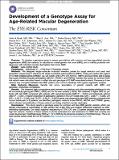Por favor, use este identificador para citar o enlazar a este item:
http://hdl.handle.net/10261/230770COMPARTIR / EXPORTAR:
 SHARE SHARE
 CORE
BASE CORE
BASE
|
|
| Visualizar otros formatos: MARC | Dublin Core | RDF | ORE | MODS | METS | DIDL | DATACITE | |

| Título: | Development of a Genotype Assay for Age-Related Macular Degeneration: The EYE-RISK Consortium |
Autor: | Breuk, Anita de; Acar, Ilhan E.; Kersten, Eveline; Schijvenaars, Mascha M. V. A. P.; Colijn, Johanna M.; Haer-Wigman, Lonneke; Bakker, Bjorn; Jong, Sarah de; Meester-Smoor, Magda; Verzijden, Timo; Missotten, Tom O. A. R.; Monés, Jordi; Biarnés, Marc; Pauleikhoff, Daniel; Hense, Hans W.; Silva, Rufino; Nunes, Sandrina; Melo, Joana B.; Fauser, Sascha; Hoyng, Carel B.; Ueffing, Marius; Coenen, Marieke J. H.; Klaver, Caroline C. W.; Hollander, Anneke I. den | Palabras clave: | Age-related macular degeneration Genetics Genetic counseling Genetic testing |
Fecha de publicación: | 24-jul-2020 | Editor: | American Academy of Ophthalmology | Citación: | Ophthalmology (2020) | Resumen: | Purpose To develop a genotype assay to assess associations with common and rare age-related macular degeneration (AMD) risk variants, to calculate an overall genetic risk score (GRS), and to identify potential misdiagnoses with inherited macular dystrophies that mimic AMD. Design Case-control study. Participants Individuals (n = 4740) from 5 European cohorts. Methods We designed single-molecule molecular inversion probes for target selection and used next generation sequencing to sequence 87 single nucleotide polymorphisms (SNPs), coding and splice-site regions of 10 AMD-(related) genes (ARMS2, C3, C9, CD46, CFB, CFH, CFI, HTRA1, TIMP3, and SLC16A8), and 3 genes that cause inherited macular dystrophies (ABCA4, CTNNA1, and PRPH2). Genetic risk scores for common AMD risk variants were calculated based on effect size and genotype of 52 AMD-associated variants. Frequency of rare variants was compared between late AMD patients and control individuals with logistic regression analysis. Main Outcome Measures Genetic risk score, association of genetic variants with AMD, and genotype–phenotype correlations. Results We observed high concordance rates between our platform and other genotyping platforms for the 69 successfully genotyped SNPs (>96%) and for the rare variants (>99%). We observed a higher GRS for patients with late AMD compared with patients with early/intermediate AMD (P < 0.001) and individuals without AMD (P < 0.001). A higher proportion of pathogenic variants in the CFH (odds ratio [OR] = 2.88; P = 0.006), CFI (OR = 4.45; P = 0.005), and C3 (OR = 6.56; P = 0.0003) genes was observed in late AMD patients compared with control individuals. In 9 patients, we identified pathogenic variants in the PRPH2, ABCA4, and CTNNA1 genes, which allowed reclassification of these patients as having inherited macular dystrophy. Conclusions This study reports a genotype assay for common and rare AMD genetic variants, which can identify individuals at intermediate to high genetic risk of late AMD and enables differential diagnosis of AMD-mimicking dystrophies. Our study supports sequencing of CFH, CFI, and C3 genes because they harbor rare high-risk variants. Carriers of these variants could be amendable for new treatments for AMD that currently are under development. | Descripción: | The EYE-RISK Consortium: Université Bordeaux, Inserm, Bordeaux Population Health Research Center, Bordeaux, France: Soufiane Ajana, Audrey Cougnard-Grégoire, Cécile Delcourt, Bénédicte M. J. Merle; Institute for Ophthalmic Research, Eberhard Karls University Tübingen, University Clinic Tübingen, Tübingen, Germany: Blanca Arango-Gonzalez, Sascha Dammeier, Sigrid Diether, Sabina Honisch, Ellen Kilger, Marius Ueffing; AYOXXA Biosystems GmbH, Cologne, Germany: Tanja Endermann, Markus Zumbansen; Pro-Retina Deutschland, Aachen, Germany: Franz Badura; Department of Regeneration and Cell Therapy, Andalusian Molecular Biology and Regenerative Medicine Centre (CABIMER), Seville, Spain: Berta De la Cerda; Barcelona Macula Foundation, Barcelona, Spain: Marc Biarnés, Anna Borrell, Lucia L. Ferraro, Míriam Garcia, Jordi Monés, Eduardo Rodríguez; Department of Epidemiology, Erasmus Medical Center, Rotterdam, The Netherlands: Johanna M. Colijn, A. Ikram, Caroline C. W. Klaver, Magda Meester-Smoor, Timo Verzijden, Johannes Vingerling; Radboud University Medical Center, Nijmegen, The Netherlands: Anneke I. den Hollander, Thomas J. Heesterbeek, Caroline C. W. Klaver, Eveline Kersten, Eiko K. de Jong, I. Erkin Acar, Anita de Breuk; Centre for Experimental Medicine, Queen’s University Belfast, Belfast, United Kingdom: Eszter Emri, Imre Lengyel; Roche Innovation Center Basel, F. Hoffmann-La Roche Ltd., Basel, Switzerland: Hanno Langen, Everson Nogoceke; Centre for Public Health, Queen’s University Belfast, Belfast, United Kingdom: Tunde Peto; Institute of Ophthalmology, University College London, London, United Kingdom: Phil Luthert, Frances M. Pool. | Versión del editor: | https://doi.org/10.1016/j.ophtha.2020.07.037 | URI: | http://hdl.handle.net/10261/230770 | DOI: | 10.1016/j.ophtha.2020.07.037 | ISSN: | 0161-6420 |
| Aparece en las colecciones: | (CABIMER) Artículos |
Ficheros en este ítem:
| Fichero | Descripción | Tamaño | Formato | |
|---|---|---|---|---|
| PIIS0161642020307259.pdf | 1,84 MB | Adobe PDF |  Visualizar/Abrir |
CORE Recommender
SCOPUSTM
Citations
34
checked on 17-mar-2024
WEB OF SCIENCETM
Citations
34
checked on 24-feb-2024
Page view(s)
126
checked on 18-abr-2024
Download(s)
146
checked on 18-abr-2024
Google ScholarTM
Check
Altmetric
Altmetric
Este item está licenciado bajo una Licencia Creative Commons

